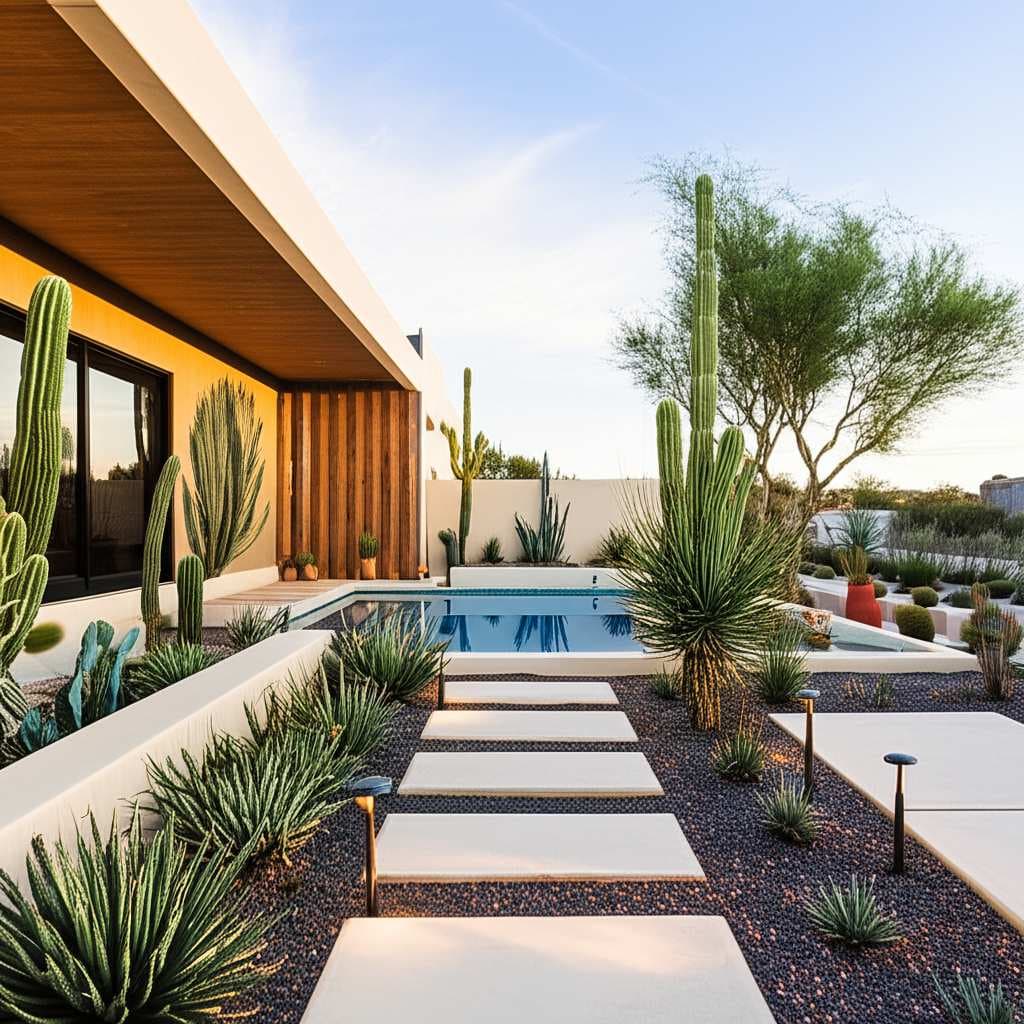Desert Modernism: Transform Your Yard and Cut Water Bills by 80%
Imagine stepping into a backyard where sculptural plants rise from gravel beds, clean lines define the space, and everything feels purposeful and serene. This vision captures desert modernism, a design approach that turns arid challenges into elegant, sustainable landscapes. Homeowners who face rising water costs and maintenance demands now embrace this style, which combines xerophytic plants with modern aesthetics to create efficient, beautiful outdoor areas.
Desert modernism goes beyond basic water conservation: it integrates environmental harmony with striking visual appeal. Traditional lawns consume vast amounts of water and require ongoing care, while xerophytic designs use resilient plants that thrive with minimal resources. The outcome delivers substantial savings, reduced upkeep, and a timeless look that enhances any home.
Understanding Xerophytic Plants and Their Benefits
Xerophytic plants have evolved to endure dry conditions through specialized adaptations, such as water-storing tissues and reflective surfaces that minimize evaporation. These features make them ideal for landscapes in arid regions, where they provide texture, color, and structure without demanding frequent watering.
Consider these popular options for your design:
- Agave: Its dramatic rosette form serves as a natural focal point, with varieties like Agave americana growing up to six feet wide in full sun.
- Aloe: This succulent requires watering only every few weeks once established, and it produces vibrant flowers that draw bees and butterflies.
- Desert Spoon (Dasylirion): The spiky leaves create dynamic movement, perfect for adding height in borders or containers.
- Cacti varieties: From barrel cacti to prickly pear, these plants offer sculptural interest and tolerate extreme heat with almost no maintenance.
- Yucca: Tall stalks and sword-like leaves complement modern architecture, and species like Yucca filamentosa adapt well to poor soils.
These selections not only slash water use by up to 80 percent compared to grass lawns but also withstand heat waves and nutrient-poor soils far better than conventional greenery.
Step-by-Step Guide to Building Your Desert Modernist Landscape
Start the transformation by assessing your current yard and setting clear goals for water savings and aesthetics. This preparation ensures a cohesive result that aligns with your lifestyle and budget.
-
Eliminate Thirsty Turf: Begin by removing existing grass, which often accounts for 70 percent of residential water use. Replace it with materials like crushed granite or permeable pavers to improve drainage and reduce runoff.
-
Design with Geometric Precision: Establish a framework using straight pathways, rectangular planters, and minimalist hardscapes. These elements create a sense of order and amplify the modern feel.
-
Select and Repeat Key Plants: Choose three to five xerophytic species and place them in repeating patterns. For example, group agaves along a walkway for rhythm, which prevents visual clutter and simplifies care.
-
Layer Textures for Visual Interest: Combine smooth surfaces like polished concrete with rough elements such as river rock or corten steel. This contrast highlights the plants and adds depth to the design.
-
Integrate Functional Shade: Position structures like aluminum pergolas or native trees such as mesquite to provide relief from intense sun. Aim for 30 to 50 percent shaded area to make the space comfortable year-round.
-
Set Up Smart Watering Systems: Install drip irrigation with timers and soil sensors to deliver precise amounts of water. This setup can reduce usage by half during the establishment phase, which typically lasts three to six months.
Follow these steps over a weekend for small areas or spread them across several weeks for larger projects, and you will see water bill reductions within the first month.
Budgeting, Maintenance, and Long-Term Value
Initial investments in desert modernism pay off quickly through lower ongoing costs. For a 500-square-foot yard, expect to spend $4,000 to $7,500 on removal, materials, and plants, depending on your location and choices.
Break down the expenses:
- Site Preparation: Lawn removal and base materials cost $8 to $15 per square foot, including labor if you hire professionals.
- Plant Purchases: Budget $50 to $300 per mature specimen, with smaller starts at $5 to $20 for cost-effective growth over time.
- Irrigation Upgrades: A basic drip system runs $1,500 to $3,000, but rebates in water-scarce areas can cover up to 50 percent.
Maintenance involves occasional pruning and weeding, taking perhaps two hours monthly versus weekly lawn care. Over five years, savings on water and labor often exceed $2,000, and enhanced curb appeal can increase home value by 5 to 10 percent.
Adapting to Your Local Environment
Tailor your design to regional factors for optimal results. In the Southwest, focus on plants that handle alkaline soils, while coastal arid zones benefit from salt-tolerant species. Always review local regulations: many cities provide incentives for water-wise conversions, but some limit impervious surfaces to prevent flooding.
Test your soil pH and drainage before planting, adjusting with amendments if needed. For instance, add organic matter to clay soils to improve permeability, ensuring plants establish strong roots without excess water.
Professional Insights and Safety Tips
As an experienced landscape editor, I have seen countless homeowners succeed by starting with a professional consultation. Experts can identify site-specific issues, such as poor drainage or invasive species, and recommend solutions that avoid costly mistakes.
If you tackle the project yourself, prioritize safety by wearing protective gear when handling spiky plants and using proper tools for digging. For complex installations, engage certified landscapers to ensure structural integrity and compliance with codes.
Why Desert Modernism Delivers Lasting Results
This approach succeeds because it aligns design with natural conditions, creating spaces that require minimal intervention yet remain visually compelling. You gain not just savings but a yard that reflects thoughtful stewardship of resources.
Getting Started Today
Begin with a pilot area: convert a small lawn section to test plants and materials. Monitor water use and adjust as needed. For full transformations, partner with specialists in xeriscape design to craft a custom plan.
Desert modernism offers a practical path to sustainability, blending efficiency with elegance to lower bills and elevate your home's appeal.
